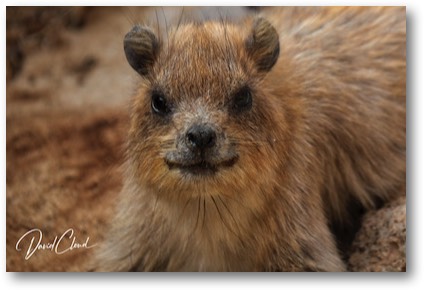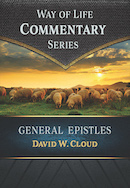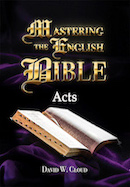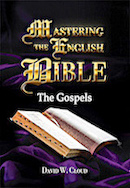
The Coney (Hyrax) photo by David Cloud
The name “coney” means rabbit, and the creature looks a lot like a fat rabbit. It is also called the rock rabbit, rock badger, and dassie. The modern name for the coney is hyrax, which means mouse. The Latin name for the coney family is Procavia.
The Hebrew word is “shaphan” (shaw-fawn) which means hiding. The Hebrew root saphan is translated “treasure” in De. 33:19 Shaphan was also the name of a scribe in the days of King Josiah who participated in the revival (e.g., 2 Ch. 34:8, 15, 16, 18, 20). Four of Shaphan’s sons are mentioned in Jeremiah and Ezekiel. Ahikam protected Jeremiah (Jer. 26:24). Elasah carried Jeremiah’s letter to the captives in Babylon (Jer. 29:3). Jaazaniah was one of the 70 men Ezekiel saw sacrificing to idols in the temple (Eze. 8:11). Gemariah is mentioned in Jer. 36:11. Two of Shaphan’s grandsons are also mentioned in Scripture. Micaiah, son of Gemariah, told the other princes of the words of Jeremiah’s prophecies that had been written by Baruch the scribe (Jer. 36:11-14). Gedaliah, son of Ahikam, was made the governor of Judah after the destruction of Jerusalem (Jer. 39:14).
In addition to Israel and Lebanon, the coney inhabits a large portion of Africa and the western and eastern coasts of Arabia.
The coney resembles a large guinea pig or ground hog. It ranges in size from 12 to 23 inches long, 8 to12 inches high, and weighs 4 to 13 pounds (1.8 to 5.4 kilos).
Scientists divide hyraxes into rock, tree, and bush varieties, but they are closely related. The main difference is their living habitat. The rock and tree conies are so alike in appearance that “it is sometimes difficult to differentiate among them.” The tree coney is nocturnal and more solitary and bears one to two pups rather than two to four as the rock coney.
The rock coney is covered with thick brown and buff/gray fur with lighter colored fur on its chest and underside. The color of its fur varies from dark brown to light grey and almost orange, depending on its habitat.
It has short rounded ears, a stubby tail, and short legs. Extra-long hairs that stick out of its body called guard hairs “help the hyrax feel its way around, the same way a cat uses its whiskers” (“Rock Hyrax,” San Diego Zoo).
Its feet are designed for climbing. Its soles are made of soft, elastic rubbery pads that are kept moist by sweat glands and are controlled by specialized muscles to act like suction cups. Its rounded toes are also covered with rubbery skin that enables it to grip slippery rocks and branches. It has four toes on its front feet and three on the back. The inside toe on each hind foot has a clawlike nail that is used for grooming and scratching.
It has excellent eyesight and can spot a predator over 1,000 yards away.
It has large incisors that have enamel on only one side, creating a self-sharpening cutting edge.
It has a complex, multi-chamber stomach that uses symbiotic bacteria to break down tough plant materials (“Hyrax,” New World Encyclopedia).
In the desert, the coney gets most of its water from the plants it eats. It also has specialized kidneys that “retain water so that they can better survive in arid environments.”
With its deep black eyes and black nose, it has an interesting face when viewed from the front. The shape of its mouth, with its cleft under the nose, gives it an inquisitive and harmless appearance.
Rock conies are social creatures that live in colonies of up to 50 individuals. One male rock coney tends to dominate a large group of females. They stay close together and often feed together in a circle formation, with their heads pointing to the outside for mutual protection.
The coney is not a very active creature. It spends a large part of its time sunning and basically doing nothing. Radio-tracking of 10 tree conies in Rwanda found that they are active only 16% of the time (“Activity patterns and feeding behaviour of the tree hyrax,” African Journal of Ecology, Dec. 13, 2002). Rock conies are thought to be even less active.
Colonies of rock conies use one rock face as a latrine which easily identified, as their urine forms white deposits.
The rock coney bears two or four pups, which are born with their eyes and ears open and can run, jump, and climb soon after birth. The colony congregates the pups into “nursery groups,” with the mothers taking turns watching them.
Rock coneys are noisy creatures with at least 21 different vocalizations, “including trills, yips, grunts, wails, snorts, twitters, shrieks, growls, and whistles.” The male rock coney can sing complex songs that last several minutes (“10 Fun Facts about the Rock Hyrax,” Wired, Jan. 2, 2014). The tree coney has “an unearthly scream.” It “starts as a squeak or whistle, then rises to a piglike squeal and finally to a child’s scream.”
In areas where there are a lot of people, such as the Ein Gedi National Park, coneys are not very skittish and you can get fairly close to them. The dominant male is always on guard and when it gives a shrill shriek of alarm, the members of the colony scurry to shelter within the rocks and stay perfectly still until the danger has passed.
It is commonly stated that the coney is kin to the elephant and manatee (a sea creature), but this is evolutionary nonsense. Though the coney might share some features with elephants and manatees, they are really nothing at all like elephants and manatees. The coney did not evolve from any other creature.
Many varieties of conies are extinct. Some were as large as a small horse!
Reports about conies or hyraxes typically take the opportunity to take a pot shot at the Bible’s accuracy, claiming that the Bible is wrong when it says that the coney chews its cud (Le. 11:5).
The following is from “Do Rabbits Chew Their Cub? by Jonathan Sarfati, creation.com:
“In modern English, animals that ‘chew the cud’ are called ruminants. They hardly chew their food when first eaten, but swallow it into a special stomach where the food is partially digested. Then it is regurgitated, chewed again, and swallowed into a different stomach. Animals which do this include cows, sheep and goats, and they all have four stomachs. Rock badgers and rabbits are not ruminants in this modern sense.
“However, the Hebrew phrase for ‘chew the cud’ simply means ‘raising up what has been swallowed’. Coneys and rabbits go through such similar motions to ruminants that Linnaeus, the father of modern classification (and a creationist), at first classified them as ruminants. Also, rabbits and hares practise refection, which is essentially the same principle as rumination, and does indeed ‘raise up what has been swallowed’. The food goes right through the rabbit and is passed out as a special type of dropping. These are re-eaten, and can now nourish the rabbit as they have already been partly digested.
“In particular, another name for this process is called cecotrophy, because the material is taken in a pouch at the beginning of the large intestine called the cecum or ‘blind gut’ (Latin caecus = blind). In the cecum, a process called ‘hindgut fermentation’ occurs, where bacteria help digest the food by breaking down cellulose into simple sugars. Then the special dropping, called a cecotrope, is expelled and re-eaten. This cecotrope is very different from normal feces, thus cecotrophy is very different from other forms of coprophagy (eating dung) practised by animals such as pigs and dogs.
“It is not an error of Scripture that ‘chewing the cud’ now has a more restrictive meaning than it did in Moses’ day. Indeed, rabbits and hares do ‘chew the cud’ in an even more specific sense. Once again, the Bible is right and the sceptics are wrong.
“God, through Moses, was giving instructions that any Israelite could follow. It is inconceivable that someone familiar with Middle-Eastern animal life would make an easily corrected mistake about rabbits, and also inconceivable that the Israelites would have accepted a book as Scripture if it were contrary to observation, which it is not ... The Hebrew word in question is NOT specific to the process of regurgitation; it is a phrase of general movement. ... The mistake is in our applying of the scientific terms of rumination to something that does not require it” (Jonathan Sarfati, “Do Rabbits Chew Their Cud?” creation.com).
- Receive these reports by email
- www.wayoflife.org
______________________
Sharing Policy: Much of our material is available for free, such as the hundreds of articles at the Way of Life web site. Other items we sell to help fund our expensive literature and foreign church planting ministries. Way of Life's content falls into two categories: sharable and non-sharable. Things that we encourage you to share include the audio sermons, O Timothy magazine, FBIS articles, and the free eVideos and free eBooks. You are welcome to make copies of these at your own expense and share them with friends and family. You may also post parts of reports and/or entire reports to websites, blogs, etc as long as you give proper credit (citation). A link to the original report is very much appreciated as the reports are frequently updated and/or expanded. Things we do not want copied and distributed are "Store" items like the Fundamental Baptist Digital Library, print editions of our books, electronic editions of the books that we sell, the videos that we sell, etc. The items have taken years to produce at enormous expense in time and money, and we use the income from sales to help fund the ministry. We trust that your Christian honesty will preserve the integrity of this policy. "For the scripture saith, Thou shalt not muzzle the ox that treadeth out the corn. And, The labourer is worthy of his reward" (1 Timothy 5:18). Questions? support@wayoflife.org
Goal:Distributed by Way of Life Literature Inc., the Fundamental Baptist Information Service is an e-mail posting for Bible-believing Christians. Established in 1974, Way of Life Literature is a fundamental Baptist preaching and publishing ministry based in Bethel Baptist Church, London, Ontario, of which Wilbert Unger is the founding Pastor. Brother Cloud lives in South Asia where he has been a church planting missionary since 1979. Our primary goal with the FBIS is to provide material to assist preachers in the edification and protection of the churches.
Offering: Offerings are welcome if you care to make one. If you have been helped and/or blessed by our material offerings can be mailed or made online with with Visa, Mastercard, Discover, or Paypal. For information see: www.wayoflife.org/about/makeanoffering.html.





